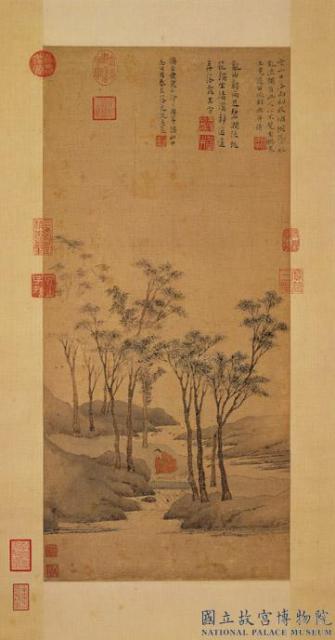明文徵明聽泉圖 軸
推薦分享
資源連結
連結到原始資料 (您即將開啟新視窗離開本站)後設資料
- 資料識別:
- 故畫001333N000000000
- 資料類型:
- 類型:繪畫
- 型式:靜態圖像
- 著作者:
- 文徵明
- 主題與關鍵字:
- 橋 高士(士人、隱士) 溪澗、湍泉
- 出版者:
- 數位化執行單位:國立故宮博物院
- 格式:
- 本幅 64.2x30公分、全幅 53公分
- 關聯:
- 石渠寶笈三編(延春閣),第四冊,頁1926&*故宮書畫錄(卷五),第三冊,頁387-388&*故宮書畫圖錄,第七冊,頁153-154&* 文徵明(西元一四七○-一五五九年),初名壁,後以字行,更字徵仲,號停雲生、衡山居士,長洲(江蘇蘇州)人,詩文書畫並佳,畫師沈周,為明四家之一。五十四歲以歲貢至京,授翰林待詔,與修武宗實錄,後厭倦京師生活,返居故里,專意藝事。 疎林間,一道清泉曲折流過,士人坐林下傾耳聽泉,樹林隱約於淡煙之中。本幅筆墨清逸靈秀,有筆簡意遠的趣味。 &*Listening to the Waterfall Wen Cheng-ming (1470-1559) Ming Dynasty Wen Cheng-ming was a native of Ch’ang-chou in Kiangsu province. Although his given name was Pi, he was best known by his style name Cheng-ming; his other style name is Cheng-chung, and sobriquet Heng-shan chü-shih. Wen excelled in the literati arts of poetry, prose, calligraphy and painting. He studied painting with Shen Chou (1427-1509) and later became one of the Four Masters of the Ming. When he was 54, he was recommended to the Emperor and appointed to the Hanlin Academy as a painter-in-attendance, and consequently also participated in editing the Wu-tsung shih-li (Records of Emperor Wu-tsung). When he tired of official life, Wen returned to his homeland, where he spent the rest of his life creating artworks. A clear stream winds through a sparse grove of trees. Beneath them, a gentleman sits with ear inclined, listening raptly to the sounds of the water. Amidst a light mist, the trees are indistinct. This painting exhibits refined and elegant brushwork, which though terse and abbreviated, has been effectively manipulated to produce an evokative and atmospheric scene. &*1.江兆申,〈文徵明聽泉圖 軸〉,收入國立故宮博物院編,《吳派畫九十年展》(臺北:國立故宮博物院,1975年初版,1976年再版,1981年三版),頁293。
- 管理權:
- 國立故宮博物院
授權聯絡窗口
- 國立故宮博物院圖像授權、出版授權、影音資料授權-申請流程說明
http://www.npm.gov.tw/zh-TW/Article.aspx?sNo=03003061






